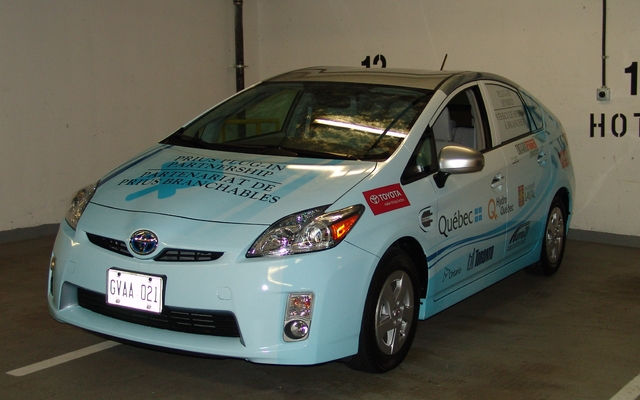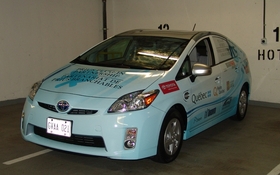Toyota Prius Plug-In: Where hybrid meets the future
When cars were first developed, and for several decades following, people were a little unsure about what type of fuel to use. Electricity, steam and gas were all in the running until about 1910. At that point, gas won out for several reasons (ease of transport, energy output, autonomy) and it held on to its position as fuel of choice for nearly a century.
Then one day we found ourselves facing a limited gas supply as well as the dark side of this type of fuel: pollution. Electricity was brought back as an alternative, and with it came some crazy expectations/aspirations. The fact is that electric and hybrid engines have always been around, used for public transit or other purposes. And by the end of the 20th century, Toyota and Honda came out with hybrid vehicles – cars that run on a combination of gas and electricity.
Waiting for the all-electric
Today, the future of cars is all-electric. But while we wait for electric vehicles capable of meeting the needs of most users (who are used to a certain independence), hybrids are the solution. A temporary one, to be sure. But a new category is starting to carve a place for itself somewhere between the hybrid and the all-electric: plug-ins. These cars are powered by "traditional" hybrid engines (if you can such technologically advanced engines "traditional") that you plug in at night (or during the day, as long as you remember to plug them in regularly!).
When launching the Scion a few weeks ago, Toyota gave journalists the opportunity to try the third generation of the Prius Plug-In (the first two generations were mostly used to fine-tune the technology). They started by explaining to us that the Plug-In has the same engine as the regular Prius. The 1.8-L Atkinson cycle gas engine and the 60-watt electric engine produce 134 hp and 105 lbs-ft of torque. And the vehicle also has a CVT transmission. The difference between the regular Prius and the Plug-In is mainly the lithium-ion batteries, which are a lot bigger in the Plug-In.
Like a Prius, but better!
The Prius Plug-In can go 20 km on electric power alone. That may not seem like much, considering the Chevrolet Volt can do sixty. However, the Plug-In’s technology is a little different. During our test drive, we kept an eye on the dash, where the remaining kilometres are indicated. Fast accelerations made that figure drop dramatically, especially on highways or secondary roads. In the city, however, where braking is frequent, that number starts to climb. Obviously, the way you drive, the weather and road conditions all affect the vehicle’s autonomy, whether you’re in electric mode or using the gas engine. The regular Prius features an EV (electric) mode, but it’s really only good for very short distances – and the driver had better not be in a hurry either. When the batteries in the Prius Plug-In start running low on power, the vehicle switches into hybrid mode (which essentially is like a regular Prius). Batteries can be recharged in three hours using a 110 V domestic outlet, or in half that time if you use a 220 V outlet. If you could drive in electric mode only, it would cost you a mere 18 cents a day, according to figures released in British Columbia.
In terms of the way it drives, the Prius Plug-In doesn’t offer anything more or anything less than a regular Prius. Sport driving is clearly not feasible, the suspension is fairly hard (especially in the back), the accelerations are nothing to write home about (granted, we didn’t have the chance to do any dynamic testing) and the soundproofing still leaves something to be desired.
Viewed from the outside, the Prius Plug is not easily distinguished from the regular version. Sure, the vehicles we tested in Vancouver were covered in hard-to-miss graphics, but I’m assuming that the sale models will be devoid of sticker collections. The only noticeable difference on the vehicle’s exterior is the access to the plug in front of the driver’s door. The interior of the vehicle is also the same, except for an additional display (as if there weren’t enough already) indicating the car’s autonomy in all-electric mode.
It’s all in the back
Even under the hood, it’s hard to spot the difference. Where you can see the difference is in the back. Since the Plug-In’s batteries are three times bigger, they had to find a way to fit them into what was already a pretty tight space. The first trick was to raise the floor in the back of the car. In the regular Prius, you’ll find storage space under the floor, and a spare tire under the storage. None of that in the Plug-In. It’s all batteries. The suspension had to be modified to handle the batteries’ 300 lbs. (136 kg) and the battery cooling system had to be adapted too. The Plug-In’s climate control is a little different in that it can draw on power from the house (or wherever you’ve plugged in the car) to heat or cool the vehicle before you get in. Yeah!
There are currently about 600 Prius Plug-Ins roaming around seven countries. That’s not a lot, I’ll admit, but Toyota, which is investing one million dollars an hour, seven days a week, 52 weeks a year, doesn’t want to rush things. Plus, there’s that tarnished image issue that’s been haunting the manufacturer for the last year... The official launch of the Prius Plug-In will be sometime in 2012. For the time being in Canada, Toyota is studying its system with 16 other companies, including Laval University and Hydro-Québec.












